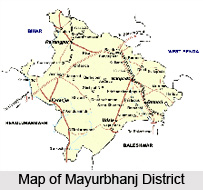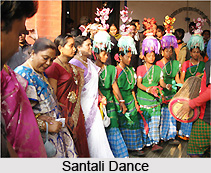 Mayurbhanj is one of the administrative district of Orissa, consists of four subdivisions Baripada, Karanjia, Udala and Rairangpur. Mayurbhanj is a land locked district with a total geographical area of 10,418 sq kms, which is round 6.68 percent of the total geographical area of the state and is situated in the northern boundary of the state with district Head quarters at Baripada. Originally a princely state of British India, the region of Mayurbhanj was merged with Orissa on 1st of January, 1949 with the identity of the separate functional district.
Mayurbhanj is one of the administrative district of Orissa, consists of four subdivisions Baripada, Karanjia, Udala and Rairangpur. Mayurbhanj is a land locked district with a total geographical area of 10,418 sq kms, which is round 6.68 percent of the total geographical area of the state and is situated in the northern boundary of the state with district Head quarters at Baripada. Originally a princely state of British India, the region of Mayurbhanj was merged with Orissa on 1st of January, 1949 with the identity of the separate functional district.
Location of Mayurbhanj District
Mayurbhanj District lies between 21 degree 16 minutes and 22 degree 34 minutes north latitude and at 85 degree 40 minutes and 87 degree 11 minutes east longitude. The district is bounded in the north by Midnapore District of West Bengal, Singhbhum District of Jharkhand in the south, Balasore District in the west and by Kendujhar District in the east.
Geography of Mayurbhanj District
The central part of Mayurbhanj District is covered by a group of hills known as the Similipal Range and the remaining portion is covered by undulating plains raising and falling in gentle slopes. Mayurbhanj District is mainly covered by a group of hills; the percentage of plain lands is quite lower in comparison to other lands. As the area is mainly undulating except along the few rivers and as it comprises ridges, slopes and depressions the agricultural lands are mostly terraced to catch the surface drainage coming from the uplands. Precisely the district may be divided into three distinct natural divisions. The central hill ranges divide the plains of the district into two halves eastern and western. The Eastern Division, which slopes gently from the foot of the hills towards the sea, is served by a number of hill streams forming an ideal land for cultivation comprising Baripada and Kaptipada sub-divisions. The western division is mainly a plain rising and falling in gentle slopes studded with many rocky mounds and hills. The northern portion of this western division is very fertile for extensive cultivation. The district is 559.31 metres above the sea level.
Stretches of leafy green forest served with a network of perennial streams and its refreshing climate contribute so much to make the district an ideal habitat for tropical flora and fauna. Diversified flora and fauna has infested the district with immaculate freshness, which is alluring to the tourist. Hence the district of Mayurbhanj is one of the significant tourist corners in Orissa. Out of the total cultivable area of 4,47,214 hectares of Mayurbhanj District, 1,95,441 hectares (around 43.7 percent) constitute high land, 1,24,730 hectares (nearly 27.9 percent) medium land and 27043 hectares (28.4 percent) low land. The soil is generally acidic in reaction. The soil types noticed are sandy loam and Lateritic, light textured with low water retentive capacity.
Economy of Mayurbhanj District
In spite of the storehouse of a huge quantity of economically important mineral resources, due to the lack of roper infrastructure the district is not industrially developed. Hence, economy of Mayurbhanj District is mostly dependent on agriculture. The agro climatic zone and the favorable soil type induce the proper growth of agriculture in the district of Mayurbhanj. Paddy is the major cultivated crop, followed by pulses and oilseeds. While there has been decrease in the coverage of Khariff paddy in high lands, the area under pulses, oilseeds and other cereals has been showing an increasing trend due to diversifications of cropping pattern in such land. Moreover the land utilisation pattern is quite accommodating for the genesis in the field of agriculture.
 Quite a good number of small scale industries including Mineral grinding, Stone Crushing, China-Clay Washing, Ceramic industries, Fertilizer, Safety Matches, Paper Mill, Paints and Chemicals, Washing, Soap, Electrical Items, High-Voltage, cable manufacturing, Aluminum Utensils, Cold Storage, Mechanised Hatchery, General Fabrication, Sheet-Metals, Poly-leaf Cups and plates making, cement products, Sabai products, rice-Huller, flour mill and allied repairing and servicing etc. serve the industrial economy of Mayurbhanj District.
Quite a good number of small scale industries including Mineral grinding, Stone Crushing, China-Clay Washing, Ceramic industries, Fertilizer, Safety Matches, Paper Mill, Paints and Chemicals, Washing, Soap, Electrical Items, High-Voltage, cable manufacturing, Aluminum Utensils, Cold Storage, Mechanised Hatchery, General Fabrication, Sheet-Metals, Poly-leaf Cups and plates making, cement products, Sabai products, rice-Huller, flour mill and allied repairing and servicing etc. serve the industrial economy of Mayurbhanj District.
Administration of Mayurbhanj District
Mayurbhanj District is divided into four administrative sub-divisions namely Sadar sub-division with headquarters at Baripada; Bamanghaty sub-division with head quarters at Rairangpur; Panchpir sub-division with headquarters at Karanjia and Kaptipada sub-division with headquarters at Udala. The district is divided into nine tehsils, 26 Community Development blocks, 316 Gram Panchayats, 3718 Villages, 26 Police stations, 16 police out-posts and four major towns. The number of Lok Sabha and Assembly seats for the district is 1 and 10 respectively.
Culture of Mayurbhanj District
Culture of Mayurbhanj District is heavily influenced by the indigenous traditions and beliefs of the tribal people as Mayurbhanj is a tribal dominated district. Out of 62 different tribal communities in Orissa, Mayurbhanj alone houses 53. The major tribes found in Mayurbhanj are the Santhal tribe, Kolha, Bhuyan, Bathudi Bhuyan, Gond tribe, etc. The tribes constitute 57.67 percent of the total population of this district. They are almost dependent on settled cultivation and forest produces. The Khadia, Mankadia and Lodha are primitive tribal groups of special mention in the district. A number of fairs and festivals constitute the culture of Mayurbhanj District. Like for instance, Ersim (Paddy sowing festival), Harialism, Jamtala Bonga (Jantal Festival), Karama Parva and Makar Parva are some of the main festivals of this district. The handicrafts in the district of Mayurbhanj were in a manner acknowledged as an important part of rich cultural heritage of this region. Handicrafts of Mayurbhanj are available in several materials and forms namely stone carving, stone wares, Dhokra, Brass and Bell Metal wares, Artistic Mats, Wooden painted items, lacquered toys, Terracotta, Sabai-Grass product, Cane craft and Bamboo crafts, musical instruments, costume jewellery, folk paintings, Tassar Textiles, Solapith work and Sea shell items.
Tourism in Mayurbhanj District
Tourism in Mayurbhanj District offers visits to several places of interest including holy sites. The District of Mayurbhanj preserves many temples built in different styles of magnificent architecture, such as Rekha, Bhadra and Gauriya. Among the Rekha temples the most important are the temples of Kakharua Baidyanath at Manatri of this district and that of Lord Jagannath at Baripada. Other tourist spots of Mayurbhanj District include Similipal, Deokund, Devagram, Lulung, Khiching, Kuchai, Manatri, Haripur, Badasahi, Bhimkund and Simla. In the eyes of tourists, the spot, which is bewitching and enthralling, is Similipal National Park, the ideal habitat of animals like tiger, leopard, elephant, deer and birds.
Mayurbhanj District is a rural district of Orissa. Mayurbhanj district is also considered as one of the `Non Industrial` districts of the state.






